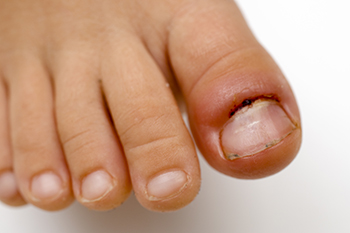
Metatarsal foot pain, or metatarsalgia, occurs when the ball of the foot is subjected to excessive pressure, resulting in pain and inflammation. Metatarsal foot pain can develop from placing excessive strain on the forefoot. Among the causes are repetitive stress from running and jumping, wearing improper footwear like high heels or tight shoes, and carrying excess body weight. Structural foot issues, including bunions, hammertoes, high arches, or a stiff Achilles tendon, may also contribute to metatarsal foot pain by altering weight distribution across the foot. Symptoms include a burning or aching sensation in the ball of the foot that gets worse with standing or movement. It also may feel as if there is a small pebble in your shoe when you bear weight. A podiatrist can assess the underlying cause of metatarsal foot pain and recommend orthotics, footwear adjustments, or surgery, if needed. If you are experiencing pain in the ball of your foot, it is suggested that you schedule an appointment with a podiatrist for an exam, diagnosis, and appropriate treatment.
Foot Pain
Foot pain can be extremely painful and debilitating. If you have a foot pain, consult with Dr. Thomas E. Silver from Westwood Foot Clinic. Our doctor will assess your condition and provide you with quality foot and ankle treatment.
Causes
Foot pain is a very broad condition that could be caused by one or more ailments. The most common include:
- Bunions
- Hammertoes
- Plantar Fasciitis
- Bone Spurs
- Corns
- Tarsal Tunnel Syndrome
- Ingrown Toenails
- Arthritis (such as Gout, Rheumatoid, and Osteoarthritis)
- Flat Feet
- Injury (from stress fractures, broken toe, foot, ankle, Achilles tendon ruptures, and sprains)
- And more
Diagnosis
To figure out the cause of foot pain, podiatrists utilize several different methods. This can range from simple visual inspections and sensation tests to X-rays and MRI scans. Prior medical history, family medical history, and any recent physical traumatic events will all be taken into consideration for a proper diagnosis.
Treatment
Treatment depends upon the cause of the foot pain. Whether it is resting, staying off the foot, or having surgery; podiatrists have a number of treatment options available for foot pain.
If you have any questions, please feel free to contact our office located in Golden Valley, MN . We offer the newest diagnostic and treatment technologies for all your foot care needs.

A toe infection can cause pain, swelling, redness, and discharge, making daily activities difficult to complete. Common causes of toe infections include fungal infections like athlete’s foot or toenail fungus, bacterial infections from cuts or injuries, and ingrown toenails. Fungal infections thrive in warm, moist environments and can spread through shared surfaces or personal items. Bacterial infections often develop when bacteria enter the skin through small breaks, such as improperly trimmed nails or blisters. People with diabetes or circulation problems are at a higher risk, as they may not feel early symptoms, which allows infections to get worse. Signs of a more serious infection include fever, warmth surrounding the toe, or red streaks moving up the foot. Without treatment, an infection can spread to deeper tissues, increasing the risk of serious complications. A podiatrist can diagnose the cause of your infected toe, clean the affected area, and recommend the appropriate treatment. Antifungal medication, antibiotics, or minor procedures to remove infected tissue are among the options. If you believe your toe has become infected, it is suggested that you schedule an appointment with a podiatrist for an exam, diagnosis, and treatment.
Toe pain can disrupt your daily activities. If you have any concerns, contact Dr. Thomas E. Silver of Westwood Foot Clinic. Our doctor can provide the care you need to keep you pain-free and on your feet.
What Causes Toe Pain?
Most severe toe pain is caused due to a sports injury, trauma from dropping something heavy on the toe, or bumping into something rigid. Other problems can develop over time for various reasons.
Toe pain can be caused by one or more ailments. The most common include:
- Trauma
- Sports injury
- Wearing shoes that are too tight
- Arthritis
- Gout
- Corns and calluses
- Hammertoe
- Bunions
- Blisters
- Ingrown toenails
- Sprains
- Fractures (broken bones)
- Dislocations
When to See a Podiatrist
- Severe pain
- Persistent pain that lasts more than a week
- Signs of infection
- Continued swelling
- Pain that prevents walking
Diagnosis
In many cases the cause of toe pain is obvious, but in others, a podiatrist may want to use more advanced methods to determine the problem. These can range from simple visual inspections and sensation tests to X-rays and MRI scans. Prior medical history, family medical history, and any recent physical traumatic events will all be taken into consideration for a proper diagnosis.
Treatment
Treatments for toe pain and injuries vary and may include shoe inserts, padding, taping, medicines, injections, and in some cases, surgery. If you believe that you have broken a toe, please see a podiatrist as soon as possible.
If you have any questions please feel free to contact our office located in Golden Valley, MN . We offer the newest diagnostic tools and technology to treat your foot and ankle needs.

Advancements in forefoot surgery are providing better treatment options for conditions that cause chronic pain and mobility issues. Mallet toes and hammertoes develop when toe joints become bent due to muscle imbalances, often leading to stiffness, corns, and discomfort. Traditional correction methods required significant recovery time, but newer techniques use tiny implants or absorbable pins to realign the toes with minimal scarring and faster healing. Neuromas, which cause burning pain or numbness between the toes, result from thickened nerves due to prolonged pressure or irritation. Instead of removing the nerve entirely, modern approaches focus on nerve decompression or cryoablation, reducing symptoms while preserving function. Metatarsophalangeal joint instability, or MTP, can lead to toe dislocation and chronic joint pain. Innovations in ligament repair and joint-stabilizing implants help restore alignment and prevent future dislocations. These surgical improvements mean less pain, quicker recovery, and better long-term function. If foot pain is affecting your daily life, it is suggested that you see a podiatrist who can discuss the best treatment options available.
Foot surgery is sometimes necessary to treat a foot ailment. To learn more, contact Dr. Thomas E. Silver of Westwood Foot Clinic. Our doctor will assist you with all of your foot and ankle needs.
When Is Surgery Necessary?
Foot and ankle surgery is generally reserved for cases in which less invasive, conservative procedures have failed to alleviate the problem. Some of the cases in which surgery may be necessary include:
- Removing foot deformities like bunions and bone spurs
- Severe arthritis that has caused bone issues
- Cosmetic reconstruction
What Types of Surgery Are There?
The type of surgery you receive will depend on the nature of the problem you have. Some of the possible surgeries include:
- Bunionectomy for painful bunions
- Surgical fusion for realignment of bones
- Neuropathy decompression surgery to treat nerve damage
Benefits of Surgery
Although surgery is usually a last resort, it can provide more complete pain relief compared to non-surgical methods and may allow you to finally resume full activity.
Surgical techniques have also become increasingly sophisticated. Techniques like endoscopic surgery allow for smaller incisions and faster recovery times.
If you have any questions please feel free to contact our office located in Golden Valley, MN . We offer the newest diagnostic and treatment technologies for all your foot and ankle needs.

